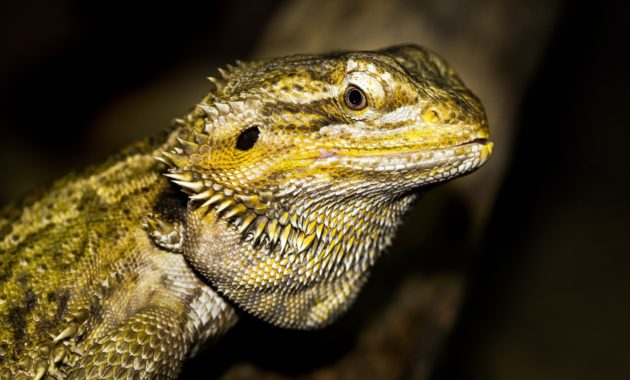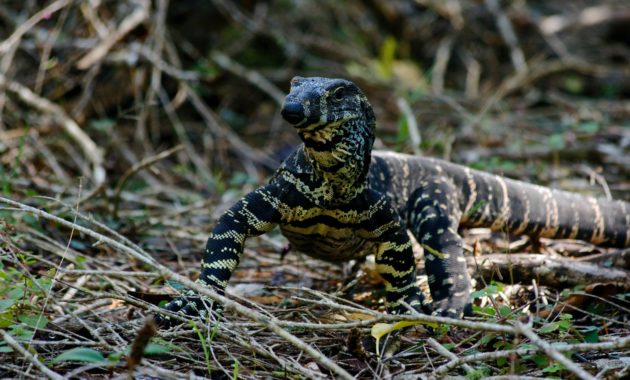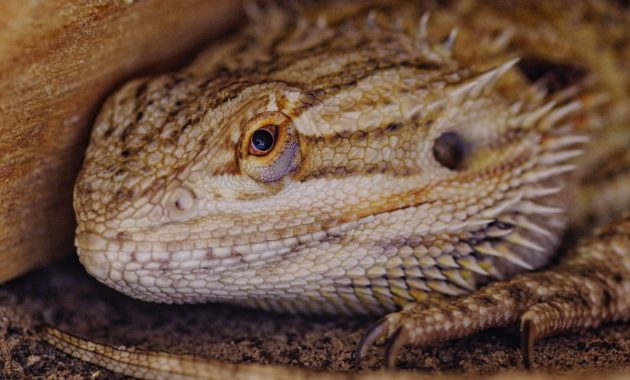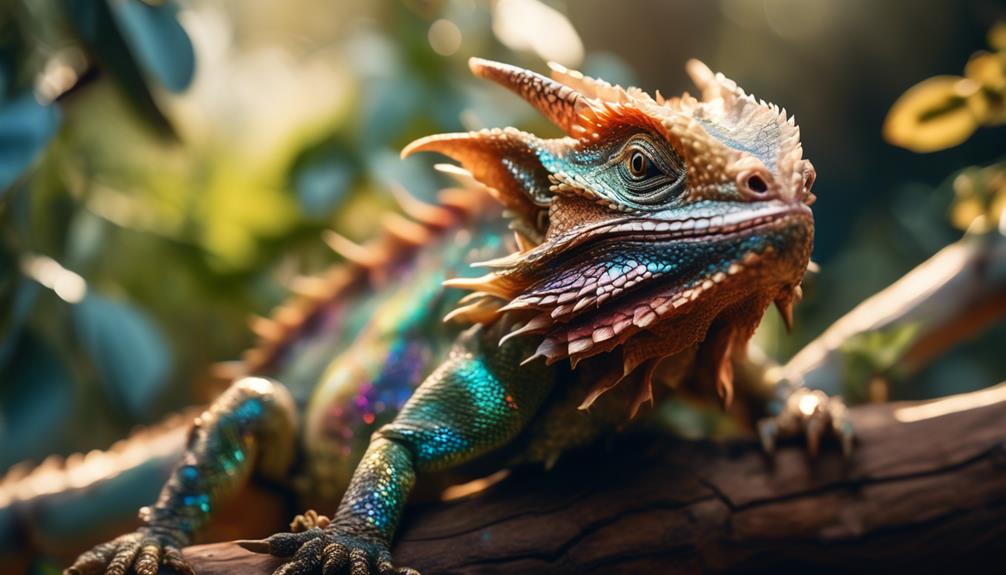
The mysterious world of Australian dragons holds many intriguing species, each with its own unique characteristics and allure.
Among these enigmatic creatures is the elusive Pogona microlepidota, a rare gem seldom seen beyond the borders of Australia. With its distinctive striped pattern and mesmerizing coloration, this small-scaled dragon captivates the imagination of reptile enthusiasts around the globe.
But what sets this remarkable species apart from its better-known relatives? How does it navigate its native habitat and interact with its surroundings? And what challenges does it face in terms of conservation?
In this exploration of the rare Australian dragon, we will uncover the captivating secrets of Pogona microlepidota, shedding light on its hidden world and unveiling the wonders that await those who dare to venture into its realm.
Key Takeaways
- The Kimberley Bearded Dragon, also known as the Small-Scaled Dragon, is a rare and unique reptile species found in northwest Australia.
- It is rarely kept as a pet and is considered an exotic pet that requires specific care and habitat conditions.
- The Kimberley Bearded Dragon is adapted to harsh conditions such as extreme temperatures and arid landscapes, and is found in rocky areas for hiding and basking.
- Conservation efforts, including protected area designation, research and monitoring programs, and habitat restoration initiatives, are being implemented to protect the vulnerable species from threats such as habitat loss, climate change, and mining activities.
Common Name and Classification
The Kimberley Bearded Dragon, also known as the Small-Scaled Dragon, is a rare Australian reptile species belonging to the Pogona genus. It is one of eight species within this genus, which includes Pogona henrylawsoni, Pogona barbata, Pogona microlepidota, and Pogona minor.
While it is rarely kept as a pet, it is not commonly found outside of Australia and is considered an exotic species. The Kimberley Bearded Dragon is smaller than the more well-known Pogona vitticeps, with a maximum length of 28 cm. It exhibits a light to dark striped pattern with colors ranging from black, brown, and orange.
This species is commonly found in northwest Australia and shares common behaviors with other Pogona species, such as arm waving as a sign of submission and male head bobbing to signal desire to mate.
Pet Status and Rarity
Given the rarity and limited presence of the Kimberley Bearded Dragon outside of Australia, its pet status and availability are quite unique. This species is rarely kept as a pet and is not commonly found outside of Australia. Due to its limited distribution and unique characteristics, the Kimberley Bearded Dragon is considered an exotic pet.
Along with other species in the Pogona genus, such as Pogona henrylawsoni, Pogona barbata, Pogona microlepidota, and Pogona minor, it is highly sought after by reptile enthusiasts. However, potential owners should be aware that this dragon requires specific care and habitat conditions to thrive.
Its rarity and exotic nature make it a prized addition to any reptile collection, but proper research and preparation are necessary to provide the best possible care for this unique species.
Description
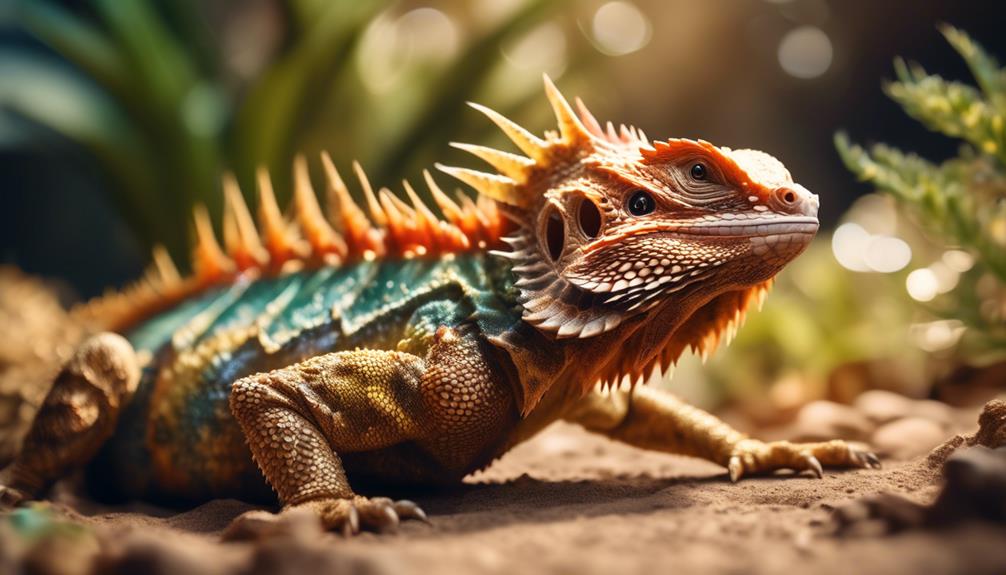
The Kimberley Bearded Dragon, also known as the Small-Scaled Dragon, is a unique reptile species found in northwest Australia. This small dragon species showcases several distinguishing features:
- Maximum length of 28 cm: The Kimberley Bearded Dragon is smaller than its counterpart, Pogona vitticeps.
- Striped pattern: It exhibits a light to dark striped pattern with colors ranging from black and brown to orange.
- Geographic location: The Kimberley Bearded Dragon is commonly found in northwest Australia.
- Similar behaviors: It shares common behaviors with other species in the Pogona genus, such as arm waving as a sign of submission and head bobbing to signal the desire to mate.
These characteristics make the Kimberley Bearded Dragon a fascinating and unique reptile species in the Australian wildlife.
Geography
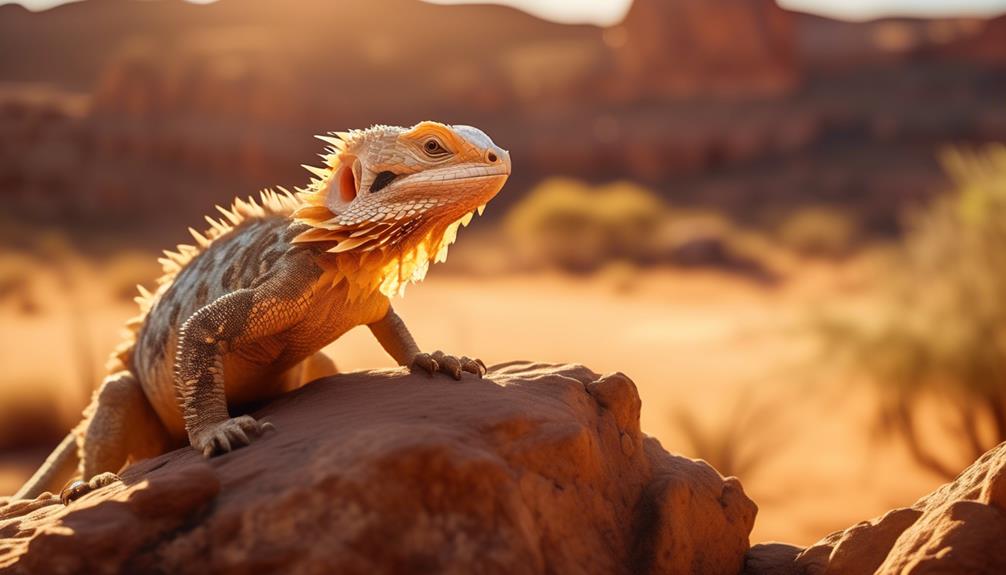
Located in northwest Australia, the Kimberley Bearded Dragon inhabits a unique geographic region. This species is commonly found in the Kimberley region of Western Australia, which is characterized by its rugged terrain and diverse ecosystems.
The Kimberley Bearded Dragon thrives in this area due to its ability to adapt to the harsh conditions, such as extreme temperatures and arid landscapes. It is often found in rocky areas, where it can hide and bask in the sun to regulate its body temperature.
The geographic isolation of the region has played a significant role in shaping the evolution and distinct characteristics of this species. As a result, the Kimberley Bearded Dragon is considered a unique and valuable part of Australia’s biodiversity.
Behavior and Other Facts
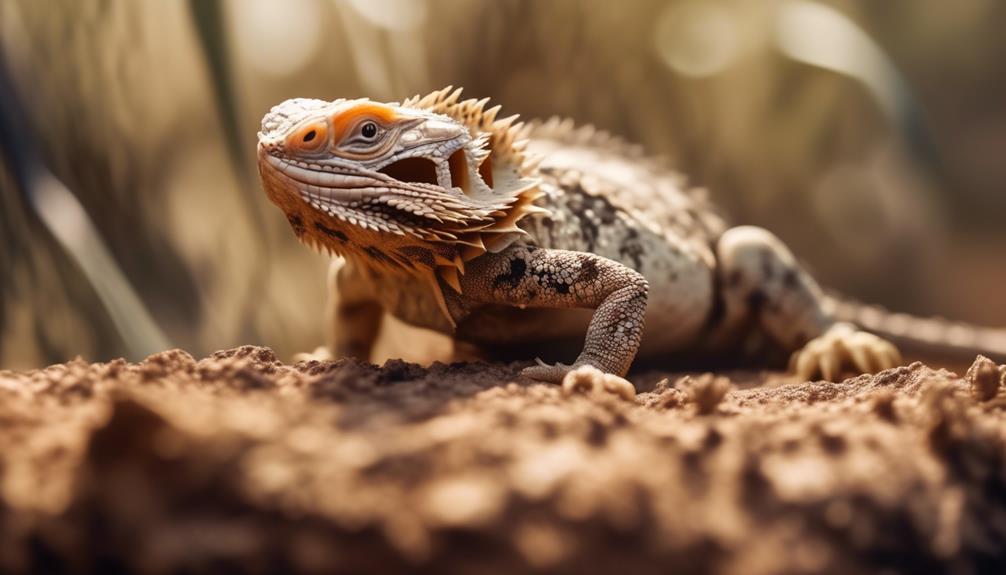
The behavior and characteristics of the Kimberley Bearded Dragon make it a fascinating and unique species of reptile. Here are some interesting facts about this rare Australian dragon:
- Shares common behaviors with other Pogona species
- Arm waving as a sign of submission
- Male signals desire to mate through head bobbing
- Requires specific care and habitat conditions
The Kimberley Bearded Dragon, scientifically known as Pogona microlepidota, is native to Australia and is not commonly found outside of the country. It is rarely kept as a pet and is considered an exotic reptile species.
With a maximum length of 28 cm, it is smaller than the Pogona vitticeps. The dragon exhibits a light to dark striped pattern with black, brown, and orange colors. Commonly found in northwest Australia, this unique reptile requires specialized care to thrive in captivity.
Maximum Length and Size
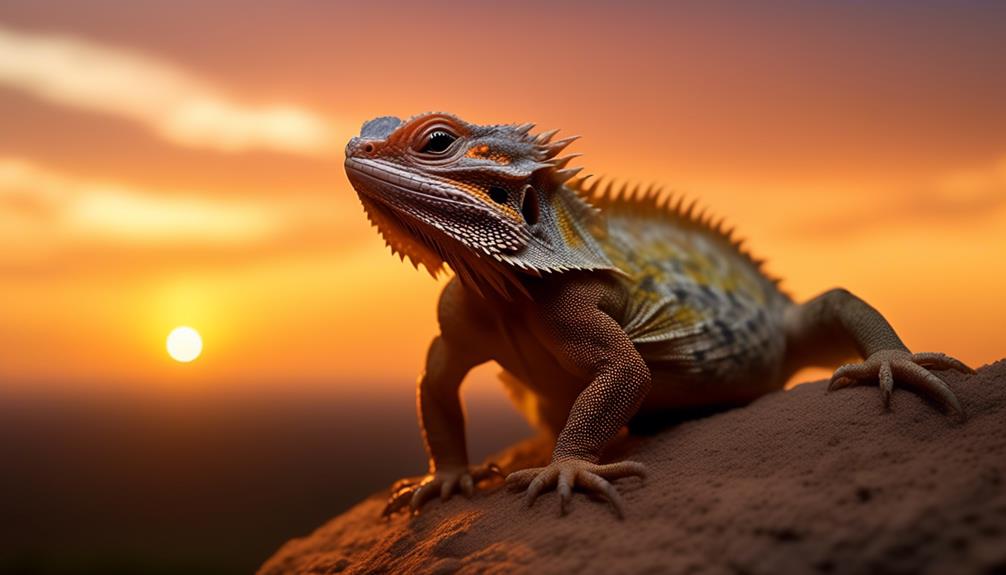
With a maximum length of 28 cm, the Kimberley Bearded Dragon is smaller than the Pogona vitticeps and exhibits a unique striped pattern in shades of black, brown, and orange.
This small-scaled dragon, belonging to the Pogona genus, is rarely kept as a pet and is not commonly found outside of Australia, making it a rare and exotic species.
Native to northwest Australia, the Kimberley Bearded Dragon shares common behaviors with other members of the Pogona genus, such as arm waving as a sign of submission and male head bobbing to signal desire to mate.
Its scientific name, Pogona microlepidota, reflects its small size and distinctive scaled appearance.
In captivity, this species requires specific care and habitat conditions to thrive.
Distinctive Coloration and Pattern
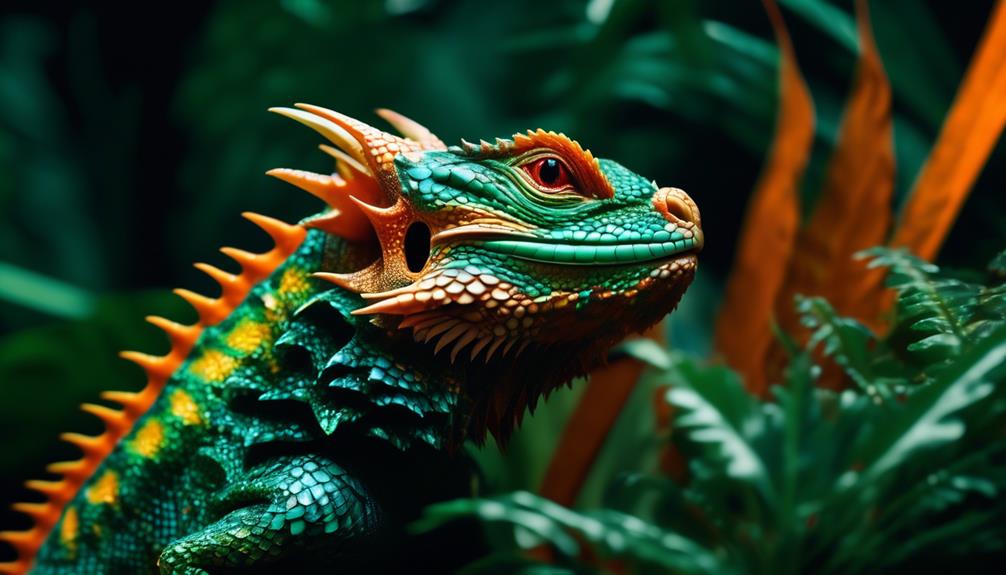
The striking Kimberley Bearded Dragon stands out not only for its small size and unique behaviors but also for its distinctive coloration and pattern. This species exhibits a light to dark striped pattern with black, brown, and orange hues. The combination of these colors creates a visually stunning appearance that is sure to capture the attention of anyone lucky enough to encounter this rare Australian dragon.
The pattern and coloration of the Kimberley Bearded Dragon’s scales are not only aesthetically pleasing but also serve a purpose in camouflage, allowing the dragon to blend into its natural habitat. The intricate design and vibrant colors of this species make it a true gem among reptiles.
Habitat Requirements and Care
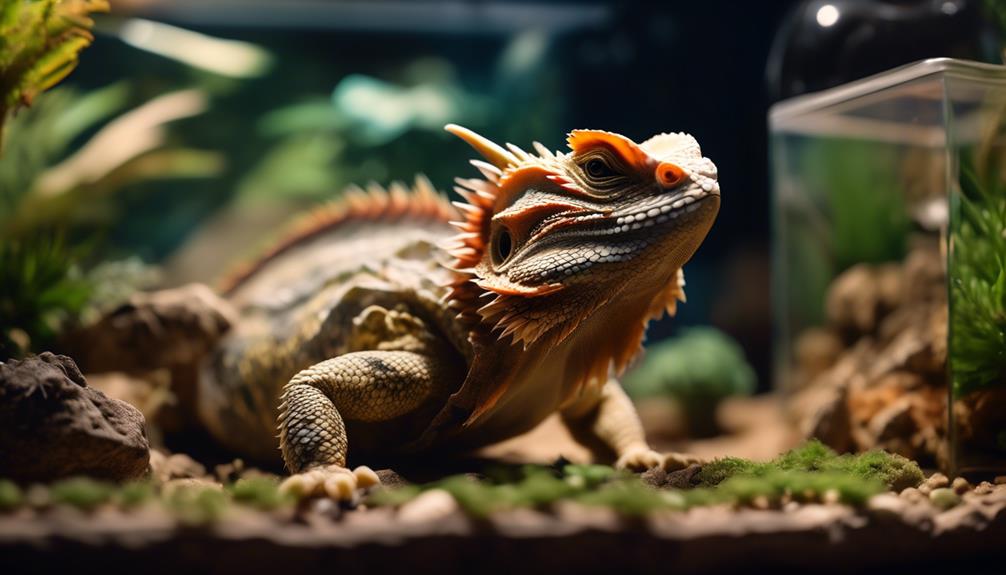
Creating an optimal habitat for the Kimberley Bearded Dragon requires careful attention to specific environmental conditions and proper care techniques. This rare Australian dragon, also known as Pogona microlepidota, is a small-scaled species found primarily in northwest Australia. As an exotic reptile species, it requires specialized care to thrive in captivity. The table below provides a concise overview of the essential habitat requirements and care techniques for the Kimberley Bearded Dragon.
| Aspect | Conditions | Care Techniques |
|---|---|---|
| Temperature | Basking spot: 35-40°C (95-104°F) | Heat lamp and thermostat for temperature regulation |
| Humidity | 30-40% | Regular misting and provision of a water dish |
| Lighting | UVB lighting for 10-12 hours a day | Full-spectrum UVB bulb and regular replacement |
| Enclosure size | At least 4 square feet of floor space | Provide branches, rocks, and hiding spots for enrichment |
| Diet | Variety of insects and leafy greens | Gut-loaded prey and calcium supplementation |
Comparison With Other Pogona Species
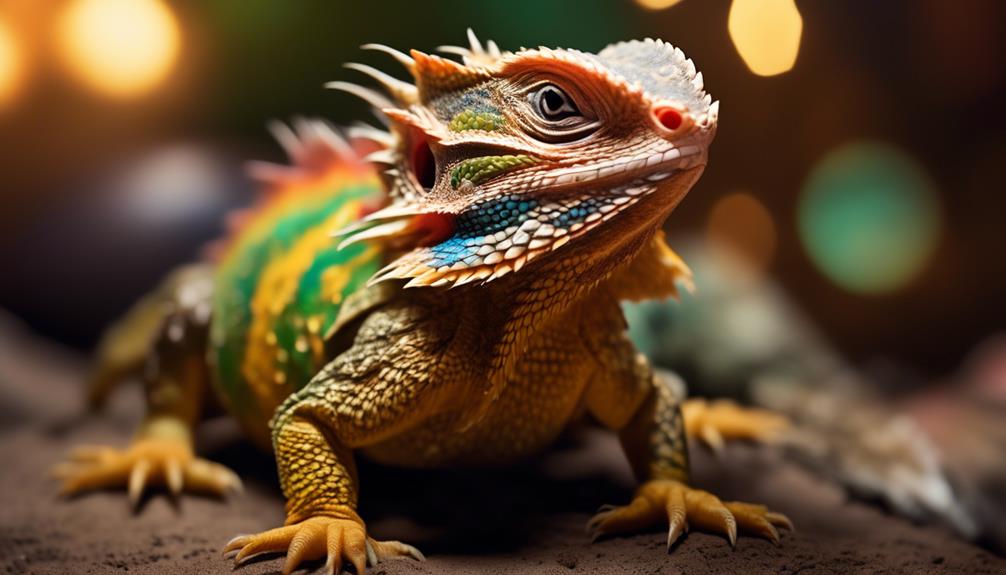
When comparing the Kimberley Bearded Dragon to other species in the Pogona genus, several distinguishing characteristics and behaviors can be observed.
- Size: The Kimberley Bearded Dragon is smaller than the Pogona vitticeps, with a maximum length of 28 cm.
- Appearance: It exhibits a light to dark striped pattern with colors ranging from black, brown, and orange.
- Distribution: This species is commonly found in northwest Australia.
- Behavior: Like other Pogona species, the Kimberley Bearded Dragon displays common behaviors such as arm waving as a sign of submission and male head bobbing to signal a desire to mate.
These distinguishing features and behaviors set the Kimberley Bearded Dragon apart from other species in the Pogona genus, highlighting its unique characteristics within the reptile world.
Conservation Status and Threats
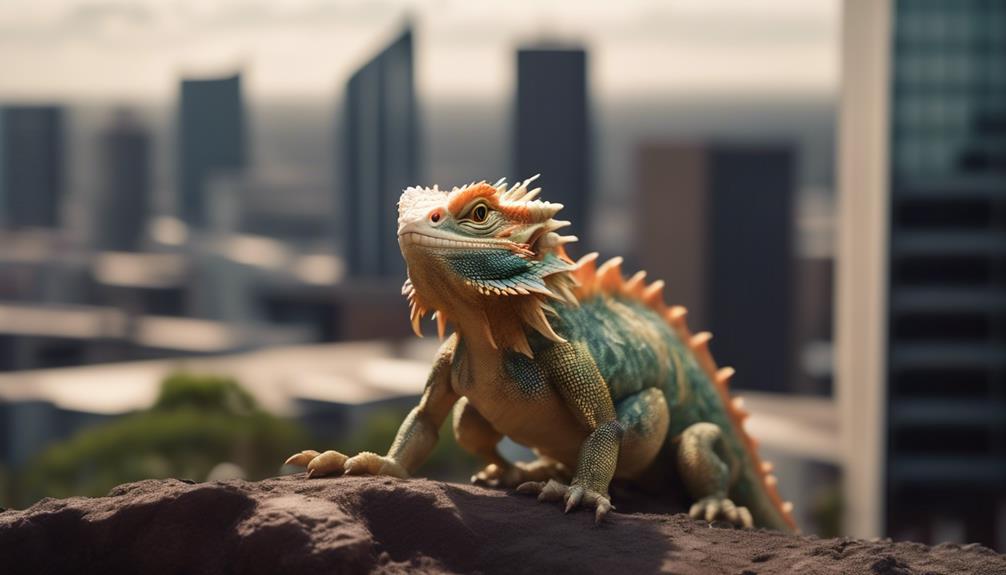
The conservation status and potential threats facing the Kimberley Bearded Dragon warrant further examination and consideration. As a rare species, the Kimberley Bearded Dragon is not commonly found outside of Australia and is rarely kept as a pet. Its restricted range in northwest Australia puts it at risk of habitat loss due to agricultural expansion, mining activities, and urbanization. Additionally, climate change poses a threat to the species as it may alter the availability of suitable habitats and affect their reproductive patterns. To provide a clearer understanding of the conservation status and threats, the following table summarizes the current situation:
| Conservation Status | Threats | Conservation Efforts |
|---|---|---|
| Vulnerable | Habitat loss | Protected area designation |
| Climate change | Research and monitoring programs | |
| Mining activities | Habitat restoration initiatives |
Efforts to protect and conserve the Kimberley Bearded Dragon include the designation of protected areas, research and monitoring programs, and habitat restoration initiatives. However, further research and conservation actions are crucial to ensure the long-term survival of this unique Australian dragon species.
Frequently Asked Questions
What Is the Average Lifespan of a Kimberley Bearded Dragon?
The average lifespan of a Kimberley Bearded Dragon, also known as Pogona microlepidota, is typically around 6 to 10 years. However, with proper care and habitat conditions, they have been known to live up to 12 years in captivity.
Can the Kimberley Bearded Dragon Be Kept as a Pet Outside of Australia?
The Kimberley Bearded Dragon, also known as Pogona microlepidota, is rarely kept as a pet outside of Australia. It is considered an exotic pet and requires specific care and habitat conditions.
How Does the Behavior of the Kimberley Bearded Dragon Differ From Other Pogona Species?
The behavior of the Kimberley Bearded Dragon, Pogona microlepidota, is similar to other Pogona species. It exhibits arm waving as a sign of submission and males signal desire to mate through head bobbing.
Are There Any Specific Dietary Requirements for the Kimberley Bearded Dragon?
The Kimberley Bearded Dragon, also known as Pogona microlepidota, has specific dietary requirements. These include a variety of insects, vegetables, and fruits. It is essential to provide a balanced and nutritious diet to ensure the health and well-being of this exotic reptile species.
What Are the Common Predators of the Kimberley Bearded Dragon in Its Natural Habitat?
The common predators of the Kimberley Bearded Dragon in its natural habitat are snakes, birds of prey, and larger reptiles. These predators pose a threat to the dragon’s survival and influence its behavior and habitat preferences.
Can Pogona Microlepidota and Eastern Bearded Dragons be Found in the Same Habitat?
The eastern bearded dragon discovery has sparked interest in whether Pogona Microlepidota and Eastern Bearded Dragons can share a habitat. While both species are found in Australia, they usually inhabit different regions due to differences in their preferred environments and dietary needs.
Conclusion
In conclusion, the rare Australian dragon, Pogona microlepidota, is a unique and sought-after reptile species due to its specific care and habitat requirements.
With its distinctive coloration and pattern, this small-scaled dragon stands out among other Pogona species.
Found predominantly in the northwest regions of Australia, it shares common behaviors with other dragons, such as arm waving and head bobbing.
As a lesser-known species, Pogona microlepidota remains a rarity in the pet trade and requires attention to conservation efforts.

